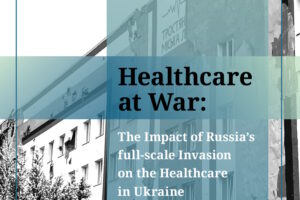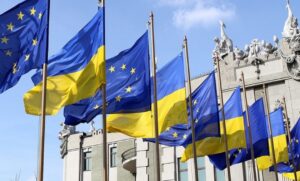
Ukraine’s population as of the end of 2022 was about 31.4 million people, of which about 1.15 million live in the temporarily occupied territories, according to experts at the Ukrainian Health Center (UHC).
“The war has resulted in an unprecedented migration crisis and large-scale internal displacements. UCH estimates that at the end of 2022, Ukraine’s population was about 31.4 million people. Of these, 1.15 million people live in the temporarily Russian-occupied territories seized after the start of the invasion,” the center’s report on the health care system after the start of the active invasion states.
The center’s experts also note that in the year after the start of the full-scale invasion, the system of outpatient and specialized medical care has fully recovered, in contrast to the system of primary medical care.
“The consumption of medical services at various levels declined in the first months after the invasion. However, outpatient and specialized medical care gradually recovered to prewar levels during 2022. Primary medical care has not resumed and requires support,” the center’s experts stressed.

European Commission Executive Vice President Valdis Dombrovskis says the European Commission has reached agreements in principle with Bulgaria, Hungary, Poland, Romania and Slovakia on the export of Ukrainian agricultural products.
“There are agreements,” he wrote in capital letters on his Twitter page Friday.
Dombrovskis said the European Commission reached “an agreement in principle with Bulgaria, Hungary, Poland, Romania and Slovakia regarding Ukrainian agri-food products.” “Together with Janusz Wojciechowski (European Commissioner for Agriculture) we have taken measures to solve the problems of both farmers in neighboring EU countries and in Ukraine,” he wrote.
The Vice President also named the key elements of the deal, which were also agreed with Ukraine. These elements include the removal of unilateral measures by Poland, Slovakia, Bulgaria and Hungary. Then there are “exceptional safeguard measures for 4 products: wheat, corn, rapeseed, sunflower seeds and a support package of 100 million euros for affected farmers in 5 member states.
In addition, Dombrovskis reported on the investigation of some other products, including sunflower oil.

The volume of IT services exports from Ukraine in the first quarter of 2023 decreased by 16 percent year-on-year to $1.68 billion, the IT Ukraine Association said in a press release on Friday.
It pointed out that for January-December 2022, IT services exports increased by $400 million compared to 2021, to $7.35 billion.
“This decline (in Q1-2023) is due to two factors: first – in previous years, the industry grew at an ultra-high rate, and second – each first quarter of a new year traditionally has a decline compared to the first quarter of the previous year. However, the results of the quarterly exports of IT-services from Ukraine in 2022-2023 show that now the industry has entered into a “flat”, that is, growth has stopped and a significant decline has not begun, “- a comment from the executive director of the Association IT Ukraine Konstantin Vasyuk said in a press release.
According to the Association, in the fourth quarter of 2021, exports of IT services from Ukraine amounted to $ 2.11 billion, in the first quarter of 2022 – $ 2 billion, in the second quarter – $ 1.74 billion, in the third quarter – $ 1.74 billion, in the fourth quarter – $ 1.87 billion. At the same time, the first quarter 2023 export figure is higher than any first quarter figure since 2014, when it was only $0.34 billion. Even in Q1 2021, the figure was lower than the current $1.44 billion. It was only surpassed in Q1 2022 at $2 billion.
It is reported that according to the Association’s observations, which are based on data from the National Bank (NBU), a similar situation took place in 2014, when the IT-sector also showed a drop of 26% and held positions $350-400 million quarterly. However, in 2016, the IT-sector resumed growth and until 2022 was adding 20% annually.
With reference to the NBU data, the IT Ukraine Association reports that IT services account for 43% of total services exports from Ukraine in the first quarter of 2023.

The Club of Experts and Maksim Urakin, PhD in Economics, have prepared a summary of the main macroeconomic indicators of Ukraine in the beginning of 2023.
So, the Ministry of Economy of Ukraine revised the macro forecast for 2023, worsening the GDP growth forecast from 3.2% to 1%, primarily because of the assumption that the military operations will not end in the middle of the year, and will last “almost a whole year”, said Deputy Minister Sergei Sobolev.
Ukraine’s real gross domestic product fell 31.4% in the fourth quarter of 2022 compared to the fourth quarter of 2021 after falling 30.8% in the third quarter, 37.2% in the second and 15.1% in the first, the State Statistics Service said Monday. At the same time, according to the consensus forecast of eight companies and non-governmental institutions, which was released by the Center for Economic Strategy, the real gross domestic product of Ukraine in 2023 will decline by 0.1%, with estimates ranging from a decline of 4.6% to growth of 5.5%. The economic recovery will be barely visible this year, expected to moderate GDP growth of 2%, which will bring real GDP at the end of this year at 70-72% of prewar 2021, such macroeconomic forecast published by ICU investment group.

According to deputy governor of the NBU Serhiy Mykolaychuk, the economic situation in Ukraine in the first quarter of 2023 is developing much better than the National Bank of Ukraine (NBU) expected in its January forecast, especially in the energy supply, so it is highly probable that the central bank will improve its current GDP growth forecast for this year by 0.3% at the end of April. Meanwhile, the International Monetary Fund forecasts the dynamics of the Ukrainian economy this year from 3% decline to 1% growth followed by 3.2% growth in 2024 and 6.5% growth in 2025.
And the International Monetary Fund (IMF), which previously estimated the dynamics of the Ukrainian economy this year from 3% decline to 1% growth, is inclined to the fact that GDP growth in 2023 may be at the upper limit of this range.
Ukraine’s GDP, after falling by 29.2% last year, will grow by 0.5% this year and by 3.5% next year, predicts the World Bank, which in January this year expected more rapid growth: by 3.3% in 2023 and by 4.1% in 2024.
At the same time, the real gross domestic product of Ukraine after growing by 3.4% in 2021 in 2022 due to full-scale Russian military aggression fell by 29.1%, and the negative balance of Ukraine’s foreign trade in goods in January-February 2023 increased 3.4 times compared to the same period in 2022 – to $3.713 billion from $1.083 billion.
The state budget deficit of Ukraine in February 2023 increased to 88.8 billion UAH from 72.3 billion UAH in January, including the general fund deficit to 93.2 billion UAH from 78.9 billion UAH.
The aggregate state debt of Ukraine in February decreased by 0.5%: in dollar terms by $0.59 billion – to $116.01 billion, in UAH terms – by UAH 21.62 billion, to UAH 4.24 trillion.
At the same time, at the end of January 2023, Ukraine’s consolidated balance of payments was $1.2 billion in surplus, while in January 2022 the deficit was $1.8 billion.
International reserves of Ukraine as of March 1, 2023, according to preliminary data, amounted to $28.865 billion, which is 3.5%, or $1.064 billion, less than in January 2023 due to interventions of the National Bank to sell currency to cover the difference between supply and demand in the foreign exchange market.
The growth of consumer prices in Ukraine in February 2023 slowed to 0.7% from 0.8% in January, returning to the level of December last year.

Ukrgraphite (Zaporizhia) increased its net profit by 42.9 times in January-March this year as compared to the similar period of the previous year – up to UAH 70.723 mln.
According to the interim report of the company, in the first quarter the company decreased its net profit by 11% – to UAH 437.326 mln.
The undistributed profits of the company as of the end of the first quarter of this year amounted to UAH 3 bln 776.257 mln.
As it was reported, Ukrgraphit reduced net income in 2022 by 41.4% compared to the previous year – to UAH 1 billion 545.562 million and received a net profit of UAH 52.584 million, while it ended 2021 with a net loss of UAH 317.539 million.
“Ukrgraphite is Ukraine’s leading manufacturer of graphitized electrodes for electric steel-making, ore-thermal and other types of electric furnaces, commodity carbon masses for Soderberg electrodes, carbon-based lining materials for metallurgical, machine-building, chemical and other industrial complexes.
According to the National Depository of Ukraine (NDU) as of the fourth quarter of 2022, Intergraphite Holdings Company Limited (Bermuda) owns 23,9841% of PrJSC, C6 Safe Group Limited (Cyprus) – 72,0394%.
The authorized capital of PrJSC – 233,959 million UAH, nominal value of 1 share – 3,35 UAH.

Kiev-headquartered investment firm Horizon Capital has raised $254 million in a new Horizon Capital Growth Fund IV (HCGF IV, the “Fund”), exceeding its $250 million target, the company said in a statement Friday evening.
“Today Horizon Capital and our esteemed group of investors made history as the first and largest fund raised since the start of a full-scale invasion,” the statement quoted company founder and CEO Olena Kosharnaya as saying from a private signing ceremony with Ukrainian President Volodymyr Zelensky and international investors from the United States, EU and international institutions.
In January this year, she told Interfax-Ukraine news agency that after raising $125 million in the first round of HCGF IV formation in September last year, it was planned to increase its size to $200 million by the end of March, and tentatively by mid-summer to completely close the formation of the fund in the originally planned amount of $250 million.
As noted in the message of the International Finance Corporation (IFC), which contributed $30 million to the fund at the initial stage of its formation, it has increased its contribution to $60 million, becoming the largest participant in the fund.
“We urge other investors to follow IFC’s lead and not let the newspaper headlines fool you. Financing sectors that others are hesitant to invest in can create tremendous investment opportunities with equally significant potential returns,” Kosharna said.
Among the new investors in HCGF IV, according to releases by Horizon Capital and the European Bank for Reconstruction and Development (EBRD), the Société de Promotion et de Participation pour la Coopération Économique (Proparco), the U.S. International Development Finance Corporation (DFC), Swedfund International AB (Swedfund), the Finnish Industrial Cooperation Fund (Finnfund) and the Danish Investment Fund for Developing Countries (IFU).
“In the context of the war with Ukraine, HCGF IV’s ambitions are unprecedented, and we are encouraged by its fundraising success,” Hassan El Khatib, managing director of equities, said in an EBRD release.
In addition to the EBRD, which contributed $40 million to HCGF IV in the first phase, its investors also included Deutsche Investitions-und Entwicklungsgesellschaft (DEG) and its subsidiary KfW Group, the Dutch Enterprise Development Bank (FMO), the Swiss Investment Fund for Emerging Markets (SIFEM) ), Western NIS Enterprise Fund and Zero Gap Fund, formed in collaboration between The Rockefeller Foundation and John D. and Catherine T MacArthur Foundation.
“The fact of exceeding the original ambitious goal of $250 million demonstrates a high level of investor interest in attractive opportunities in high-growth, high-impact technology and export-oriented companies, including those in the light and food processing, innovative consumer products, fintech, etc. sectors,” noted Horizon Capital.
It is also noted that HCGF IV was the first fund in Central and Eastern Europe (CEE) and one of about ten funds in the world to achieve 2X Flagship Fund status, including one of only two that are founded and led by women. The 2X Challenge was launched at the 2018 G7 Summit as a bold commitment by companies to invest in women in the world and promote gender equality in finance.
IFC specified that the fund would invest $10-30 million to acquire minority stakes in 10-15 mid-cap and $50-150 million companies in Ukraine and Moldova. HCGF IV is the $200 million successor to EEGF III, which was completed in 2017, and will follow a similar investment strategy focused on IT services and products as well as e-commerce, innovative consumer products and fintech, according to corporate materials.
IFC recalls having invested in EEGF III and EEGF II (2008), while EBRD was an investor in EEGF III and EEGF II as well as HCGF II.
Horizon Capital is a large investment company managing 6 private equity funds (more than 40 institutional investors) with assets of $1.4 billion, among which are WNISEF ($150 million), Emerging Europe Growth Fund (EEGF, $132 million), EEGF II ($370 million) and EEGF III ($200 million), as well as HCGF II ($258.3 million). The funds of these funds were invested in more than 160 companies, which employed more than 77 thousand people, in Ukraine and Moldova.